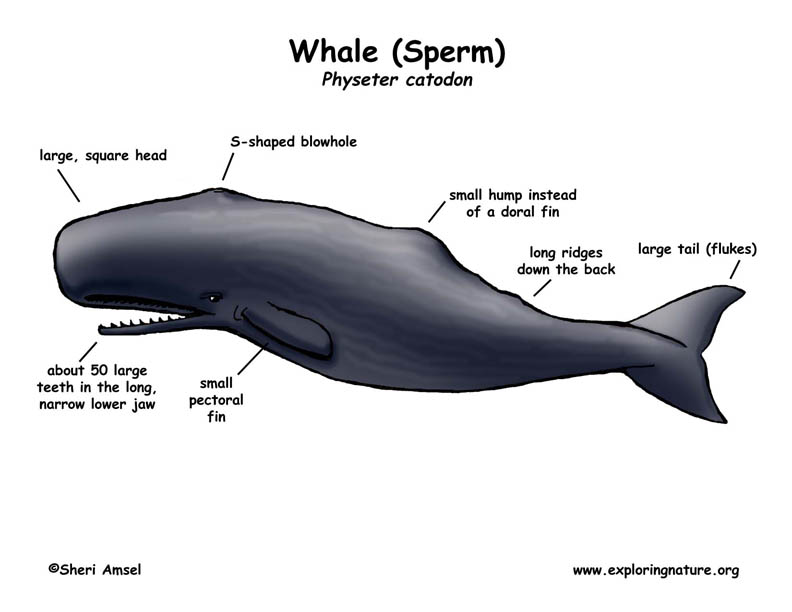

They are found throughout the world’s oceans, though are more common in temperate and tropical waters.
Now they are found more often down in the depths of the oceans, though once they were common along coastlines.
Males can weigh about 50 tons (50,000 kg) and reach more than 60 feet (19m) long, while females weight more in the range of 18 tons (18,000 kg) and reach about 40 feet (12m) long. They are grayish-colored with a huge, square-shaped head and long wavy ridges down the back. Both the dorsal and pectoral fins are quite small, but the tail (also called flukes) can reach 14-feet wide. The sperm whale’s 1-foot thick layer of blubber helps keep it warm while diving into the frigid depths of the ocean. The large head of the sperm whale has an oil-filled organ called the spermaceti organ. It is for this oil that the sperm whale was so heavily hunted, as it was useful as machine and lamp oil and for making candles, make-up, and perfume. They have the largest known brain, weighing about 20 pounds and the largest esophagus (the tube from the mouth to the stomach), thought to be able to pass a whole man. Only the lower jaw has useable teeth.
While moving through the ocean, they swim at speeds between 5-10 mph, but can reach near 20 mph if threatened. They dive deep hunting for squid and can stay under water for up to an hour. When they finally come to the surface to breathe through their blowhole, they must take up to 70 breaths before diving again. They often travel in family groups (gregarious) of 2-dozen or more whales made up of breeding females and young of many ages (nursery pods). Young males also travel together, but mature, breeding males are commonly alone because of their aggressive nature. They make many sounds including a kind of clicking voice radar, called echolocation, to communicate with other whales across many miles underwater.
They eat squid, but will also take octopuses, fish, sharks and skates. They can dive down more than 2 miles hunting for giant squid.
Their only predator is man.
Females are pregnant for up to 16 months (gestation) and have one calf in the fall every 2-5 years. The calf weighs up to a ton at birth (2,000 pounds) and will nurse for 2 years. Females don’t begin to have young until they are about 10 years old. Males can also start breeding at 10, but usually don’t until they are at least 25 because of competition from more mature, aggressive males.
They may live up to 80 years. They are listed as endangered by CITES due to over-hunting in the last two centuries. Their numbers have recovered to about 1.5 million, but some local populations, like in the Gulf of Mexico, have never come back. They were hunted not for their meat, but for the many tons of oil harvested found in their large heads – called spermaceti.
Kingdom: Animalia
Phylum: Chordata
Subphylum: Vertebrata
Class: Mammalia
Order: Cetacea
Suborder: Odontoceti
Family: Physeteridae
Genus: Physeter
Species: P. catodon
When you research information you must cite the reference. Citing for websites is different from citing from books, magazines and periodicals. The style of citing shown here is from the MLA Style Citations (Modern Language Association).
When citing a WEBSITE the general format is as follows.
Author Last Name, First Name(s). "Title: Subtitle of Part of Web Page, if appropriate." Title: Subtitle: Section of Page if appropriate. Sponsoring/Publishing Agency, If Given. Additional significant descriptive information. Date of Electronic Publication or other Date, such as Last Updated. Day Month Year of access < URL >.
Amsel, Sheri. "Whale (Sperm)" Exploring Nature Educational Resource ©2005-2024. December 13, 2024
< http://www.exploringnature.org/db/view/Whale-Sperm >

